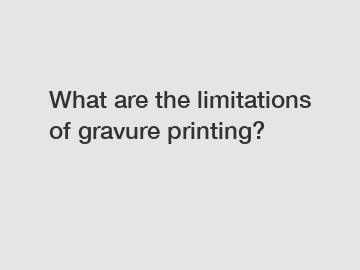What are the limitations of gravure printing?
Gravure printing is a highly versatile and efficient printing method that has been widely used in various industries for decades. From packaging to magazines, this process offers a range of benefits including high image quality and vibrant colors. However, like any other printing technique, gravure printing comes with its own set of limitations. In this blog post, we will explore some of these limitations, shedding light on the factors that may affect the final print quality and production process.
One of the primary limitations of gravure printing is the high start-up cost. Setting up a gravure printing press requires significant investments in machinery and specialized equipment. Unlike digital printing, which offers a more cost-effective option for short print runs, gravure printing is most economical for large-scale production. The costs associated with engraving cylinders, maintaining and replacing them periodically, and setting up the press can make gravure printing less accessible for small businesses or individuals with limited budgets.
Another limitation of gravure printing lies in its inability to quickly change designs or artwork. As each design requires a separate engraved cylinder, any alterations or modifications in the artwork can result in extra expenses and time-consuming processes. This makes gravure printing less suitable for projects that require frequent design changes or customization. On the other hand, digital printing methods excel in these areas, allowing for flexibility and quick turnaround times.

When it comes to printing fine details and small text, gravure printing may also face challenges. Due to the inherent nature of the process, there is a limit to the level of detail that can be reproduced compared to other high-resolution printing methods. Fine lines or intricate patterns, especially those that are smaller in size, may not be as crisp and clear in gravure prints. However, it's worth noting that advancements in technology have minimized this limitation to a certain extent, and the difference might not be as visible to an untrained eye.
Printing on non-absorbent materials can also pose a limitation for gravure printing. This technique relies on the transfer of ink from engraved cells to the substrate. If the substrate does not have sufficient porosity to absorb the ink, such as plastics or metal, the drying process may become extended, leading to potential issues with ink smearing or longer production times. In such cases, alternative printing methods like flexography or screen printing may be more suitable to ensure optimal print quality and durability.
The speed of gravure printing can be both an advantage and a limitation, depending on the application. While gravure printing is known for its high-speed production capabilities, this can sometimes compromise the accuracy or consistency of the prints. The rapid movement of the printing press can create challenges in maintaining color registration, especially for large and complex designs. This limitation can be mitigated through meticulous control of the press and production process, but it remains a factor to consider, especially for critical color matching or projects demanding utmost precision.
Despite these limitations, gravure printing continues to be a preferred choice for many due to its exceptional image quality and suitability for large print runs. The limitations mentioned earlier are not insurmountable hurdles, but rather considerations that need to be weighed against the specific requirements of each printing project. Understanding the capabilities and constraints of gravure printing allows designers, brand owners, and printers to make informed decisions, ultimately ensuring the best possible outcome for their products.
In conclusion, while gravure printing excels in many aspects, it is important to be aware of its limitations. The high start-up cost, limited flexibility for design changes, challenges with fine details and non-absorbent materials, and potential color registration issues are factors to keep in mind. By understanding the strengths and weaknesses of gravure printing, it becomes easier to determine when this technique is the ideal choice and when alternative methods might be more suitable. As with any printing technology, a holistic approach that considers the specific needs of each project will lead to the most successful and satisfying results.
Contact us to discuss your requirements of Foil Stamping Machine For Sale, Automatic Cardboard Die Cutting Machine, Box Gluing Machine. Our experienced sales team can help you identify the options that best suit your needs.


